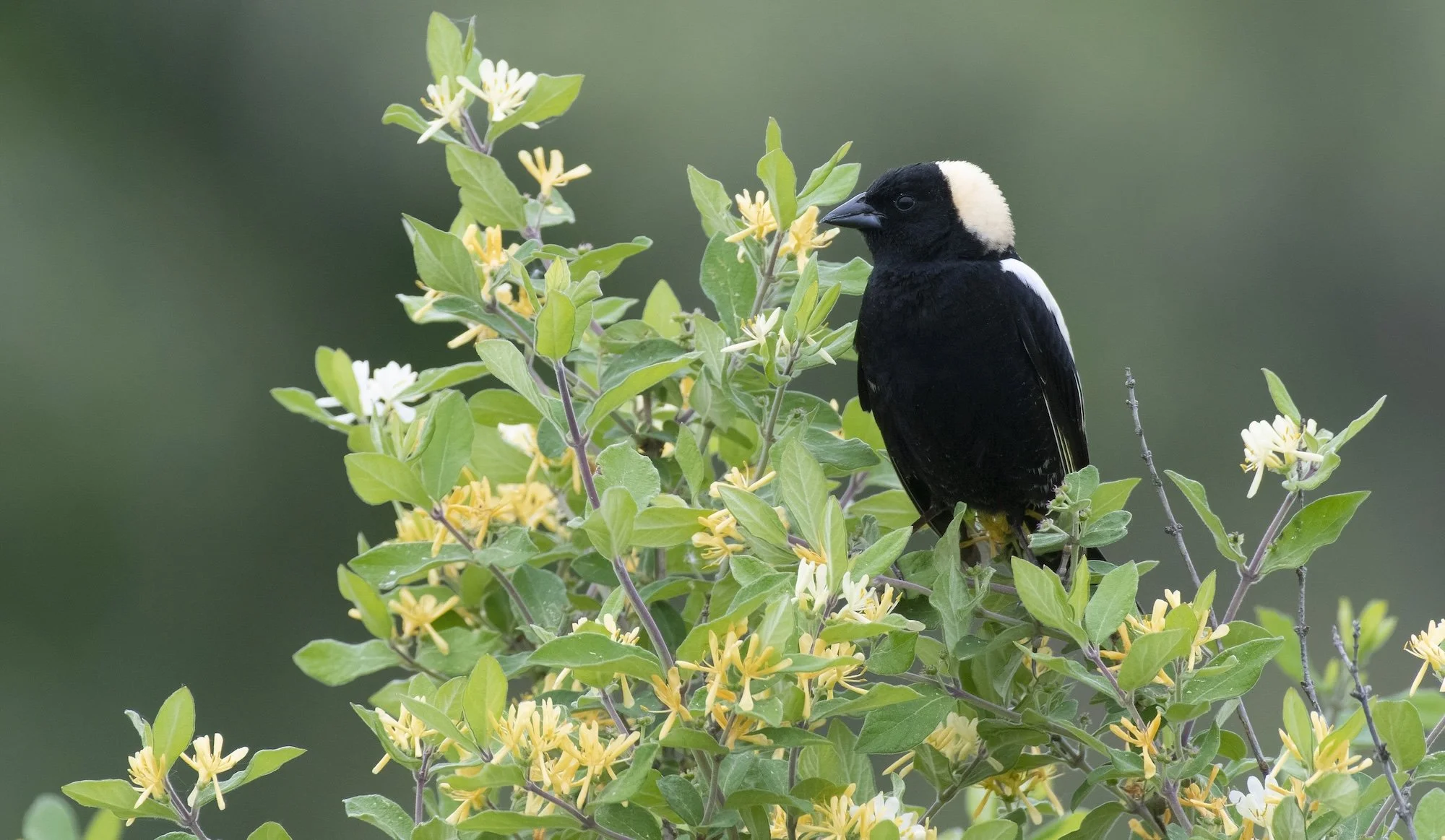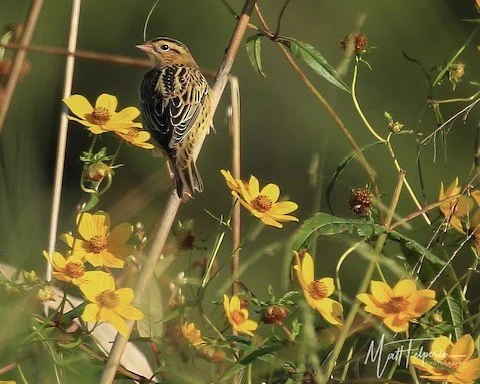Photo: Bobolink, Calvin Borgmann/Audubon Photography Awards
Evelyn Novins
The Bobolink, Dolichonyx oryaivorus, also called the rice bird or rice bunting, is yet another migrating songbird that has declined in population over the last fifty years. People have trapped and sold them as pets in South America, collected them as food in Jamaica and shot them in the US as agricultural pests. The primary reason for the species’ decline, however, is changes in land use, particularly the disappearance of useful habitat in many areas of its historic range.
The Bobolink, as a ground-nesting bird, looks for large areas dominated by grasses without woody plants or trees. With the loss of prairie land due to development and agriculture, the Bobolink has adjusted to smaller, often flower-rich open meadows and hayfields. In urbanizing areas, of course, that kind of habitat also is disappearing.
The threats are not news to most birdwatchers, but before going into too much detail on the dire circumstances (and some hopeful moves toward conservation), let’s look at the special bird in question.
The Bobolink is a seed-eater. It passes through northern Virginia in migration, breeds in more northern North America and winters in South America. During their long migration, mostly through Florida and the West Indies although a few migrate through Mexico and Central America, they stop in marshes and rice and other grain fields. In years past when the Bobolink was very abundant, flocks of birds might strip rice fields of seeds, behavior that gave it its common rice bird or rice bunting name and its scientific name “orvaivorus”, which means rice-eater. Once considered a pest, hunting the bird was a common practice.
Although John James Audubon’s Birds of America was limited to the plates, a separate, companion publication written by Audubon and Scottish naturalist and ornithologist William MacGillivray provides observations on the birds’ migration as well as the damage they caused to crops along the way. See the text for Audubon’s Plate 54, the Rice Bird. It’s interesting to compare their observations with the information in current field guides.
Male Bobolink in breeding plumage, Calvin Borgmann/Audubon Photography Awards
The breeding male Bobolink is easily identified by his stunning black and white “reverse tuxedo” plumage (black below with white above) and his straw-colored nape. The nonbreeding male and female have a yellow/buffy nape and bold, brown stripes on the wings. The breeding female is paler. Many birders, however, recognize the bird by its bubbly call, which some say gave it its name, that is, they hear “Bob O’Lincoln” as part of the song. Listen to the recording on the American Bird Conservancy's website to see if you can hear the name.
Bobolink with nonbreeding plumage, Matt Felperin
After migrating in the spring, the males arrive in the breeding ground first. Females arrive later, choosing a nest site within a male’s territory. The female scratches a depression in the soil and then builds an outer wall of dead grass and weed stems. She lines the inside of the nest with fine grasses and sedges placed directly on the soil about 2-1/2 inches deep and 2 inches across for a clutch of 3-7 eggs.
Bobolinks are truly social birds. Males mate with several females per breeding season and the eggs in a female’s clutch may represent multiple fathers. Both parents feed the young, and families from several nests form forage flocks. The adults eat seeds, but the nestlings are fed invertebrates exclusively. The young leave the nest unable to fly and hide in the underbrush until their flight feathers emerge fully. Outside the nesting season Bobolinks continue to flock, and the males molt adopting a drabber plumage as they begin their migration to the South American wintering ground. The males molt again on their wintering ground.
The 2025 State of the Birds report lists the Bobolink as an Orange Alert Tipping Point species, a classification that means it has lost more than 50% of its population in the last 50 years, and its decline has accelerated in the past 10 years. The US Geological Survey’s North American Breeding Bird Survey indicates that grassland bird populations have fallen 53%, and Partners in Flight also acknowledges the imperiled status of the Bobolink.
Conservation efforts focus on maintaining the birds’ breeding ground by refraining from mowing fields until after the young have fledged. Using prescribed burns in natural prairie habitat also prevents encroachments by trees and other woody plants. Locally, Fairfax County has implemented a timed mowing schedule at several capped mounds at the I-95 Landfill Complex. Birders spotted Boblinks there this spring as they made their way north to breed. Because of the dearth of natural, open meadows in an urbanizing area like northern Virginia, managing landfills for these (and other) imperiled birds may be the birds’ best chance for finding a resting and feeding stop on their migrations.


